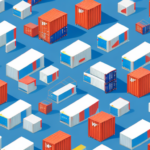Understanding the Benefits of an EIR (Equipment Interchange Receipt)
Electronic Data Interchange (EDI) has become a cornerstone of modern logistics and supply chain operations. It enables companies to streamline processes and share real-time information about shipments, inventory, and other critical data points. A pivotal component of EDI is the Equipment Interchange Receipt (EIR). This article delves into the myriad benefits of EIRs and their vital role in container shipping processes.
The Importance of Accurate Equipment Tracking
Enhancing Logistics Efficiency
Accurate equipment tracking is essential for efficient logistics operations. EIRs provide a standardized method to monitor containers throughout the supply chain, helping logistics companies proactively identify and address potential issues. According to a study by McKinsey & Company, effective tracking can reduce operational costs by up to 15%
Cost Optimization and Compliance
Precise tracking not only ensures timely and correct deliveries but also aids in optimizing operations and reducing costs. Analyzing data on equipment usage and movement allows companies to minimize empty container movements and optimize routing, leading to significant cost savings and enhanced profitability. Additionally, accurate tracking helps companies comply with regulatory requirements, such as container inspections mandated by certain countries, thereby avoiding penalties and ensuring smooth operations.
Streamlining Container Shipping Processes with EIRs
Identifying and Mitigating Bottlenecks
EIRs facilitate the identification of potential bottlenecks and delays within the supply chain, enabling logistics companies to take corrective actions swiftly. For instance, EIRs can highlight containers ready for pickup, allowing for the efficient allocation of resources and reducing turnaround times.
Improving Communication and Security
By providing real-time updates on container status and location, EIRs enhance communication between logistics providers, shipping lines, and port authorities. This improved collaboration leads to faster container processing and increased customer satisfaction. Furthermore, detailed information about container contents aids in enhancing security measures, allowing authorities to identify and mitigate potential risks effectively.
EIRs in International Trade Compliance
Ensuring Regulatory Adherence
EIRs play a crucial role in maintaining compliance with international trade regulations. They offer a standardized approach to tracking container movements across borders, simplifying adherence to customs and border requirements. Moreover, EIRs provide essential information that demonstrates compliance with safety and security regulations, as outlined by organizations like World Trade Organization (WTO).
Preventing Fraud and Illegal Activities
By maintaining detailed records of container contents, EIRs help prevent fraudulent activities and the illegal transport of goods. Discrepancies in shipping documentation can be easily identified, reducing the risk of smuggling and misdeclared cargo, thereby safeguarding the integrity of international trade.
Comparing EIRs and Bill of Lading
Key Distinctions
While both EIRs and Bills of Lading (BOLs) provide important information about containers and their movement, they serve different purposes. EIRs are primarily used for tracking the physical movement of containers, whereas BOLs function as contracts between shippers and carriers, detailing terms such as price and delivery timelines.
Legal Implications
It's important to note that BOLs are legally binding documents that can be used in court to resolve disputes, whereas EIRs do not hold the same legal standing. Additionally, BOLs are typically issued by carriers or shipping lines, while EIRs are generated by terminal operators or port authorities. Understanding these differences ensures that goods are transported and delivered efficiently and legally.
Automating EIR Generation for Logistics Companies
Enhancing Accuracy and Efficiency
Automating the generation of EIRs offers numerous advantages for logistics companies. Automation reduces the likelihood of errors, improves accuracy, and accelerates the process of creating and transmitting EIRs. This efficiency is crucial for scaling operations and supporting business growth.
Improving Data Security and Staff Productivity
Automated systems ensure that sensitive information within EIRs is securely managed and accessible only to authorized personnel, mitigating the risk of data breaches. Additionally, automation frees up staff time, allowing employees to focus on strategic tasks that add greater value to the business.
Future Trends and Innovations in EIRs
Integration of Advanced Technologies
The future of EIRs is being shaped by advancements in technologies such as the Internet of Things (IoT) and geolocation. These innovations provide real-time data on container movements and conditions, enhancing the functionality and value of EIRs in logistics operations.
Leveraging Data Analytics
Data analytics is becoming increasingly integral to the use of EIRs. By analyzing data captured through EIRs, logistics companies can identify trends, optimize workflows, and make informed decisions that drive efficiency and profitability. The integration of machine learning and artificial intelligence is expected to further enhance these capabilities.
Applying Data Analytics to Improve Efficiency and Profitability with EIRs
The data contained within EIRs serves as a valuable resource for continuous improvement in logistics operations. By leveraging data analytics, companies can uncover insights into operational trends, identify inefficiencies, and develop strategies to enhance supply chain management. According to a report by Supply Chain Digital, companies that effectively utilize data analytics can achieve up to a 20% increase in supply chain efficiency.
As data analytics capabilities advance, the potential for EIRs to contribute to improved decision-making and increased profitability will continue to grow, making them an indispensable tool for modern logistics companies.
Common Challenges and Solutions When Using EIRs in Container Shipping
Data Inaccuracy and Communication Breakdowns
Despite their benefits, EIRs can present challenges such as incomplete or inaccurate data and communication breakdowns between parties. To address these issues, logistics companies should implement robust data verification processes and establish clear communication protocols among all stakeholders.
Technical Issues and System Reliability
Technical issues like system downtime can disrupt the EIR process. Investing in reliable and secure technology infrastructure is essential to minimize these disruptions. Additionally, having contingency plans in place ensures that operations can continue smoothly in the event of technical failures.
Best Practices for Effective EIR Management
- Collaborate closely with carriers and other stakeholders to ensure alignment and consistency in EIR usage.
- Automate EIR generation to enhance accuracy and speed.
- Develop comprehensive policies and procedures for managing EIRs effectively.
By adhering to these best practices, logistics companies can overcome common challenges and fully leverage the benefits of EIRs.
Conclusion
Equipment Interchange Receipts (EIRs) are a vital component of modern logistics and supply chain management. They enhance equipment tracking accuracy, streamline container shipping processes, ensure compliance with international trade regulations, and offer significant opportunities for cost optimization through automation and data analytics. As technology continues to evolve, the role of EIRs will become increasingly important, driving efficiency and profitability in the logistics industry.






















